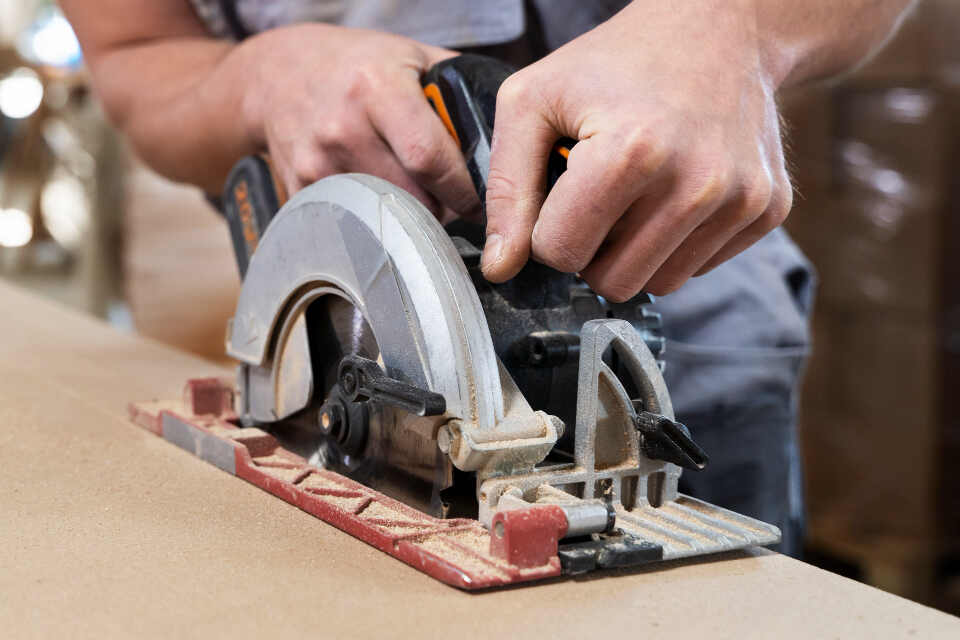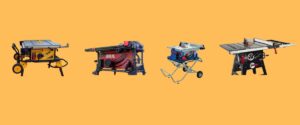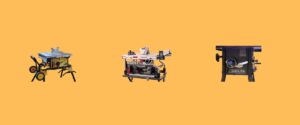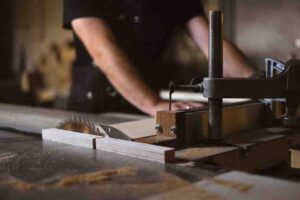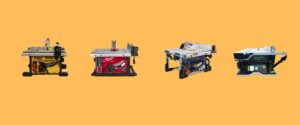When it comes to selecting the best table saw, it’s not about just throwing money at the most expensive option. It’s about understanding your needs, workspace, and the types of projects you tackle.
A high-quality table saw improves accuracy, efficiency, and safety while saving time on every cut.
No matter if you’re a beginner, a DIY enthusiast, or a professional, this table saw buying guide will help you buy the right table saw with confidence.
In this guide, you’ll learn:
- The types of table saws and which is best for specific projects
- Features that define the best table saws in 2025
- Top brands and their recommended models
- Practical tips to maintain your saw and avoid mistakes
- FAQs
What Is a Table Saw?
A table saw is a woodworking tool with a circular blade mounted on an arbor, powered by a motor. The blade extends through a table surface, giving stable support while cutting.
Why it’s essential:
- Cuts wood faster and straighter than handheld saws
- Handles rip cuts, crosscuts, bevels, and dadoes
- Saves time and improves precision
Table of Contents
Do You Really Need a Table Saw?
You might already have some tools. A circular saw can handle long cuts, while a miter saw is ideal for cutting boards to the correct length. So, why would you need a table saw?
The main reasons are accuracy, consistency, and versatility.
Accuracy: A table saw has a fixed blade and strong guides, which make it easy to cut perfect straight lines. Freehand cuts often get tricky.
Consistency: Suppose you need to cut ten boards to the exact same size. Once you set the guide, all boards will be uniform.
Versatility: A table saw doesn’t just make straight cuts. You can do angled cuts, bevels, and even special joinery cuts like rabbets or dadoes.
If your projects demand accuracy and you find yourself frustrated with the limitations of other saws, then yes, you need a table saw.
Why Choosing the Right Table Saw Matters
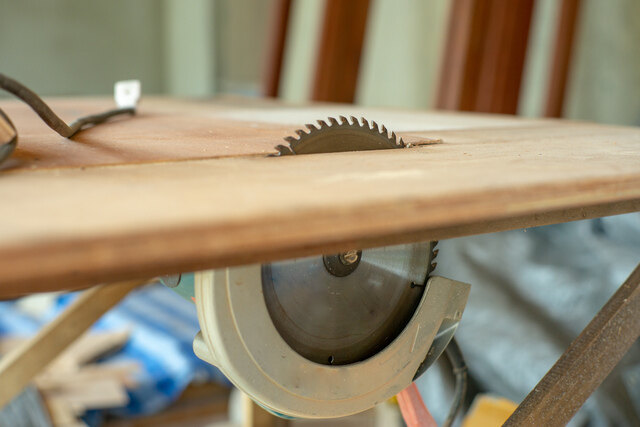
Selecting the wrong table saw can mean poor cuts, wasted materials, and even safety risks. Just think, if you try to cut a large sheet of plywood with a small saw, you will face many problems. On the other hand, a very powerful cabinet saw can be completely unnecessary for a small home workshop.
Key factors for choosing the best table saw:
- Project type: Furniture, cabinets, framing, or DIY crafts
- Frequency of use: Occasional vs daily heavy-duty cutting
- Space and portability: Workshop space or jobsite mobility
- Budget: Balancing features with affordability
If price is a concern, explore the best table saws under $500 to get quality without overspending.
Types of Table Saw
Table saws can be categorized into five main types, each suited to a specific task and user. Choosing the right saw depends on your mobility needs, power requirements, and budget. Below, we’ll outline the pros, cons, real-world examples, and recommendations for each type, helping you select the perfect table saw with easily.
Benchtop Table Saws
Benchtop saws are lightweight and portable, making them great for small workshops or garage DIY projects. I’ve used a few for trimming plywood and small boards, and they’re easy to set up in minutes.
Example: DeWalt DW745
Who I’d recommend it for:
Perfect for beginners, hobbyists, and small DIY projects like picture frames, shelves, or furniture trims. Not suitable for heavy-duty or large projects.
Jobsite Table Saws
Portable jobsite table saws are lightweight and compact in design, making them perfect for professionals who need to carry their tools from one place to another. Despite their small size, many of these models pack a lot of power and are capable of making precise cuts.
Example: DeWalt DWE7491RS and RYOBI RTS12
Who I’d recommend it for:
Contractors, mobile woodworkers, and DIYers who occasionally handle medium-sized boards. Not ideal if you need a perfectly stable saw for large or precise projects.
Contractor Table Saw
Contractor saws are built for more serious woodworking, offering a powerful motor, large rip capacity, and better stability than jobsite saws. I’ve used one for furniture projects and found it very reliable.
Example: Delta 36-725T2
Who I’d recommend it for:
Serious hobbyists or semi-professional workshops working on cabinets, furniture, or larger DIY projects. Great if you want more power and capacity without going full professional.
Cabinet Table Saw
Cabinet saws are the gold standard for professional woodworking. I’ve spent hours on these, and the stability, precision, and power are unmatched.
Example: Powermatic PM2000
Who I’d recommend it for:
Professional woodworkers, commercial workshops, and anyone doing frequent large-scale cabinetry or furniture projects. Beginners or hobbyists probably don’t need this level of power.
Hybrid Table Saws
Hybrid table saws combine the easy moving of a contractor saw with the strong cutting power of a cabinet saw. Think of it this way, you get a closed base that controls dust and low noise, which doesn’t bother you even after long hours of use. These saws are especially popular with home workshops, who want professional performance but don’t want to take up extra space. This combination of portability and powerful features is what makes hybrid saws a favorite among many
Example models: ShopFox W1819
Who I’d recommend it for:
Advanced DIYers or small workshop owners who want cabinet saw-like performance without paying full price. Ideal for heavier projects occasionally, but not for constant professional use.
Key Features to Consider
Motor Power
The horsepower (HP) of the motor basically decides how well a saw can cut. Jobsite saws typically have 1.5 to 2 HP motors, which is enough for smaller projects. On the other hand, Cabinet saws can have 5 HP or more, making cutting dense wood or handling large projects much smoother and faster. More HP doesn’t just mean more power; it also makes the work much easier when cutting.
Blade Size and Type
Most table saws use a 10-inch blade, which can cut up to 3-1/2 inches deep at a 90-degree angle. There are different types of blades, such as crosscut, rip, and combination blades. Choosing the right blade for your project will ensure a clean and perfect cut every time. That’s why blade selection is so important.
Rip Capacity
Rip capacity refers to the maximum width of wood or plywood that can be cut with the blade. A large rip capacity will allow you to cut through large boards without having to make multiple cuts. This is especially useful when you are working on a project with large pieces of wood or plywood.
Fence System
A high-quality fence system ensures you get accurate and repeatable cuts every time. Look for fences that lock tightly and have minimal bending or deflection. Popular fence systems include T-square and Biesmeyer-style fences.
Bevel and Tilt
If your table saw has a blade tilt feature, you can make bevel cuts, which are perfect for angled joints or intricate cuts. Most saws can only tilt the blade to the left, but some models allow you to tilt it to both sides, which makes working on different projects much easier.
Safety Features
When using a table saw, safety should always be your first priority. That’s why features like blade guards, riving knives, and anti-kickback pads are essential, as they help prevent accidents. There are also more modern models, such as SawStop, that use technology that stops the blade immediately if it comes into contact with skin.
Dust Collection
Good dust collection not only keeps your workshop clean, it also helps protect your health. Many saws have built-in dust ports that can be connected to a vacuum, making cleaning much easier. Some models go a step further and offer active dust collection systems, which significantly reduce fine particles floating in the air.
Which Type of Build Quality and Design Should You Go For?
The build quality and design of a table saw play a crucial role in how stable, precise, and long-lasting your saw will be. It also affects usability—if a table wobbles or the fence system isn’t aligned properly, even a powerful motor and sharp blade won’t save you from frustrating cuts. Here’s what works best for different users:
DIYers / Home Hobbyists: A medium-sized aluminum or light steel table (around 20–24 inches deep × 22–27 inches wide) works well. It’s lightweight, portable, and easy to move around your home workshop. Paired with a standard 10-inch blade and a moderate motor (1.5–2 HP), this setup handles small panels, shelves, and drawer fronts efficiently. Ergonomic features like simple adjustment knobs and a basic fence system make beginner projects easier and safer.
Hobbyists / Small Workshop Owners: Tables made of steel or medium-weight cast iron (about 24–30 inches deep × 27–36 inches wide) offer better stability for medium-sized projects like cabinet doors, furniture panels, or multiple boards. Combined with a 2–3 HP motor and 10–12 inch blades, these tables keep cuts smooth and precise. Ergonomic layouts with micro-adjustable fences and smooth table surfaces improve workflow and reduce strain during long sessions.
Professional Contractors: For large-scale projects, heavy-duty cast iron or commercial-grade steel tables (30+ inches deep × 36–48 inches wide) are essential. When paired with high-power motors (3–5 HP) and 12-inch or specialty blades, these tables maintain stability for full 4×8 ft plywood sheets, thick hardwood boards, and repeated long cuts. Well-designed ergonomics, sturdy fences, and vibration-reducing surfaces make professional-level work safer, more accurate, and more efficient.
Always consider table material and size alongside motor power and rip capacity. A powerful motor on a flimsy table can still produce inaccurate cuts. Integrating this build quality info with performance specs gives readers a clear picture of how the saw will handle real projects.
Top Table Saw Brands
- DeWalt: It is known for making reliable and powerful table saws that are suitable for both professional and DIY users.
- Bosch: Bosch table saws are very popular for their precision and innovative features.
- SawStop: SawStop is well-known for its advanced safety technology. Their table saws feature a system that detects skin contact and stops the blade within milliseconds, preventing serious injuries.
- Skil: These table saws are budget-friendly, but they don’t compromise on quality.
- Milwaukee: Milwaukee builds its table saws tough, so they can handle heavy-duty work with ease.
Warranty and support
- DeWalt: 3-year warranty & 1 year free service
- SawStop: Fantastic safety support and parts availability
- Bosch/Skil: 1–3 years, depending on product line
Maintenance Tips
Regular Cleaning: Keep the table and components free from sawdust and debris to ensure smooth operation.
Blade Maintenance: Sharpen or replace blades as needed to maintain cutting efficiency.
Lubrication: Apply lubricant to moving parts to prevent rust and ensure smooth adjustments.
Safety Checks: Regularly inspect safety features like blade guards and riving knives to ensure they function correctly.
For detailed instructions, check our table saw safety tips & maintenance guide.
Frequently Asked Questions (FAQs)
What is the difference between a jobsite and a cabinet table saw?
Jobsite table saws are designed for portability, so they can be easily taken anywhere. On the other hand, cabinet table saws remain stationary and provide extra power and precision for larger, heavier work.
Can I use a table saw to cut materials other than wood?
Yes, with the appropriate blade, table saws can cut materials like plastic, acrylic, and non-ferrous metals.
How do I maintain my table saw?
Regular maintenance includes cleaning, blade sharpening, lubrication, and safety feature inspections.
What safety features should I look for in a table saw?
Essential safety features include blade guards, riving knives, anti-kickback pawls, and emergency stop mechanisms.
Final Thoughts
Selecting the right table saw depends on your needs, budget, and the type of project you’re working on. If you’re new, it’s best to choose a jobsite or contractor saw with safety features. DIY enthusiasts can go for contractor models, as they’re sturdy yet easy to move. Professionals who want high precision and extra power should opt for a cabinet saw. Whichever saw you choose, always prioritize safety and maintain it well so that it lasts a long time.

Welcome to Homenias, I’m Jaman M, and I’m here to help you discover the best home products. With years of experience, they offer genuine reviews and helpful guides. Their mission is to make your choices easier. It’s organizing your space or finding creative solutions. Explore how the right products can enhance your everyday life. Don’t miss out on finding the best home products to raise your living experience.

